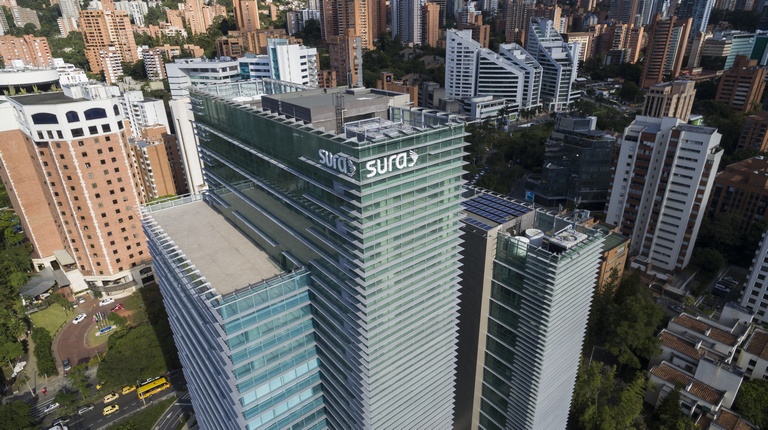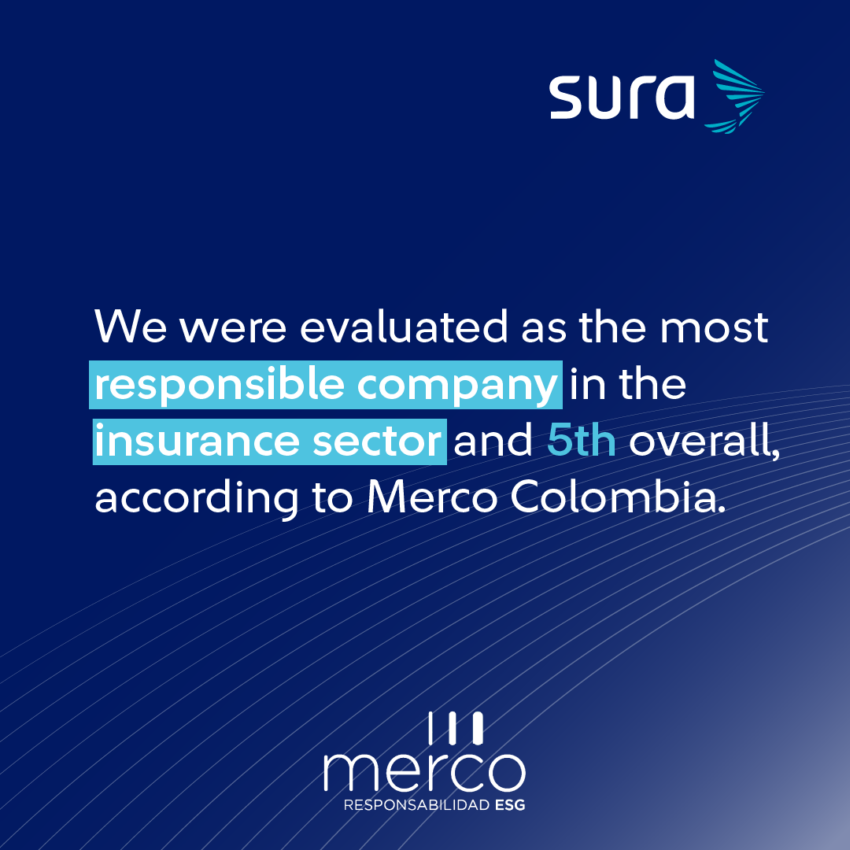The integration of environmental, social and governance (ESG) criteria into portfolio management has transformed the global investment landscape. Sectors such as investment banking, insurance, and fund management in Latin America are no exception
By Valora Analitik for GRUPO SURA*.
The application of ESG (environmental, social and governance) criteria in investment portfolio management has evolved significantly in recent years, driven by a growing awareness of sustainability and the need to make financial decisions that not only generate economic returns, but also have a positive impact on the environment as well as society.
This phenomenon in Latin America has become particularly relevant due to the sustainability agenda driven by events such as the COP16 being held this year in Colombia, where the focus of discussion is expected to be on the protection of biodiversity, as well as drawing up agreements on issues such as energy transition, emissions reduction and the role of the financial sector in these matters.
It is estimated that meeting climate action commitments within the region requires an investment of between 3.7% and 4.9% of the regional GDP per year until 2030, according to a report by the Economic Commission for Latin America and the Caribbean (ECLAC) presented as part of the COP28 held at the end of last year.
Furthermore, according to the Inter-American Development Bank (IDB), the acquisition of thematic bonds in Latin America rose by more than 20% last year, with 55% of these going to sustainable projects, 20% to bonds linked to sustainability, 10% to green bonds and 20% to sustainable bonds.
Therefore, banks, insurance companies and fund managers are incorporating these criteria in their investment strategies, considering new methodologies, the types of investments they promote and how these trends consolidate their portfolios and put them in a more competitive position in today's market.
As Lina Uribe, Head of Sustainability at Grupo SURA, points out, “in the last 10 years, investors' interest in incorporating ESG criteria in investment strategies has grown significantly. It is no longer just a matter of being profitable, but of demonstrating responsible and sustainable management in an increasingly demanding environment”.
Global context of ESG criteria in investing
ESG criteria around the world, are no longer just a trend but have become an integral part of investment decisions. According to the Bloomberg data, the value of assets managed under ESG criteria exceeded USD 40 trillion in 2023 and this figure is expected to continue to rise in the coming years. This reflects a paradigm shift in which both institutional and individual investors are prioritizing sustainability alongside financial returns.
The Bloomberg forecasts highlight that, assuming a 15% growth, which is a third of the pace of the last five years, ESG assets could exceed USD 50 trillion by 2025. This outlook comes amid an environment of uncertainty in the face of increasing pressure prevailing on the financial markets and disparate macro policies among some of the world's major powers.
In Latin America, the integration of ESG criteria has also gained traction in the context of the commitments made by each country to meet Sustainable Development Goals (SDGs) and greenhouse gas (GHG) emission reduction targets. Banks, insurance companies and fund managers are playing a key role in channeling capital to projects that contribute to these goals.
According to Mauricio Rodríguez, Chief Investment and Wealth Management Officer at Protección, “when we talk about investment geared towards issues such as biodiversity or the protection of nature , we need initiatives and large amounts of capital in order to place that first layer of risk capital, as has already happened in deeper markets. This awareness is being created throughout the region and we are on the way to finding these common exits”.
On the other hand, according to a report on ESG criteria and institutional investment issued by Fasecolda, Colombia's Federation of Insurers, Colombian insurance companies have begun to adopt these principles as part of their responsible investment policies, with the aim of mitigating long-term risks and generating sustainable value, including specific application methodologies regarding ESG criteria.
These are used for integrating ESG criteria in portfolio management and vary depending on the sector and the nature of the investments. However, there are some common approaches that are being adopted across the board:
- ESG integration: this consists of incorporating environmental, social and governance factors into traditional financial analysis, assessing how these may affect investment performance. This approach is widely used in banking and insurance to identify risks and opportunities that may not be evident using conventional financial analysis.
- Thematic investing: this strategy focuses on investing in specific sectors or projects that promote sustainability, such as renewable energy, green infrastructure or clean technologies. For example, private equity funds in Colombia have begun to invest in projects relating to energy transition or the circular economy.
- Negative screening: consists of excluding companies or sectors that do not meet certain ethical or sustainable standards from investment portfolios. This approach is used by some fund managers and insurers to avoid investing in industries such as arms, tobacco or fossil fuels, which present reputational or sustainability risks.
- Impact investing: Impact investing goes beyond ESG integration, as it focuses on generating both a financial return and a measurable social or environmental impact. Funds that follow this methodology typically invest in projects aimed at solving specific social or environmental problems, such as poverty, access to education or climate change mitigation.
The Companies belonging to the SURA Business Group have made concrete progress in this area, in order to respond to the demands of the environment and, especially, of investors on a global level. This explains why Grupo SURA has been included for the last 13 consecutive years in the Dow Jones Sustainability Indexes and in the S&P Sustainability Yearbook, with scores going above those of 98% of all those companies belonging to the Diverse Financial Services sector.
An example of the performance of the SURA Companies in this area is the case of SURA Investments, which is promoting initiatives in thematic investing, especially in Fixed Income, where it has increased its participation in labeled securities by more than 194% throughout the region, including green, social, sustainable and sustainability-linked bonds. This reflects the Company's commitment to promoting positive impact projects and to become leaders in the Latin American sustainable debt market.
Likewise, SURA Investments is constantly seeking to further integrate ESG criteria in all of its portfolios, carrying out increasingly technical and detailed evaluations of the companies in which it invests. This goes hand in hand with efforts in infrastructure, with methodologies aligned with IFC performance standards and, in private debt, with the development of environmental and social risk management systems, in response to the growing demand from investors committed to sustainability and willing to generate a consequent impact.
Types of investments and priority sectors
The focus on sustainable investing is reflected in a growing interest in sectors that traditionally have not received as much attention from institutional investors. In the region, these include:
- Renewable energy: fund managers are increasing their exposure to wind, solar and hydro projects to reduce dependence on fossil fuels. This not only helps to meet sustainability goals, but also represents an opportunity for greater profitability given the expected growth in this sector.
- Green infrastructure: Investing in sustainable infrastructure, such as the construction of energy- and resource-efficient buildings, is gaining popularity among institutional investors, who see this sector as a way to mitigate risks associated with climate change, as well as to obtain attractive returns.
- Energy transition and electric mobility: Bancolombia has led the way in financing projects relating to sustainable mobility, such as the transition to electric public transportation fleets. The insurance sector has also begun to develop specific products for this type of asset, covering risks associated with operating electric vehicles or their charging infrastructures.
Impact measurements
A critical aspect of applying ESG criteria is being able to measure their impact There are various metrics and indicators that are used to evaluate investment performance in terms of sustainability. Some of the most common include:
- Carbon footprint: measuring the greenhouse gas emissions of investee companies. This indicator is key for investors seeking to reduce exposure to climate change-related risks.
- Gender diversity and equality: social criteria, such as inclusion and diversity on Boards of Directors and executive teams, are increasingly relevant in evaluating companies. Investors are interested in whether companies are promoting equality and diversity practices as part of their sustainability strategy.
- Transparency and governance: governance factors are an essential component in risk assessment, as companies with transparent and accountable governance structures tend to be more resilient and generate better long-term returns Banks and fund managers in Colombia are increasingly incorporating these assessments into their portfolio analysis
Outlook and consolidation in 2025
Against this backdrop, investments with a robust incorporation of ESG criteria are expected to increase by 2025. This trend is driven both by increasingly stringent sustainability regulations and a greater demand from investors, who are looking for solutions that allow them to help reduce global emissions and meet their social responsibility goals.
In fact, players such as Bancolombia Capital expect to increase their revenues by 30% and their clients' assets under management by 38%, compared to the results obtained at the end of 2024, this with a strong ESG focus. Today, this organization has an investment offering consisting of more than 18 world-class mutual fund managers, such as Pimco, BlackRock, JPMorgan, NinetyOne and Morgan Stanley.
Juan Felipe Giraldo, CEO of Bancolombia Capital, explains that in this way they have achieved significant growth in the space of two years together with a complete offering with access to multiple assets, including equities, ETFs, fixed income instruments, funds, structured products and semi-liquid alternatives, among others.
On the other hand, Grupo Credicorp deployed its Corporate Environmental Strategy. Among the main advances in environmental management, 59 green credits were labeled for an amount equivalent to more than USD 585 million through BCP, for an increase of 259% over last year. It also published the first TCFD Credicorp Report (Task force on Climate-Related Financial Disclosures), which describes the measures adopted as part of its environmental strategy. This document covers issues relating to climate change in areas such as corporate governance, business strategy, operations, risks and metrics, both at a corporate and subsidiary level.
Private equity and venture capital fund managers are also increasing their exposure to investments that prioritize sustainability. Insurance companies for their part, are playing a key role in developing financial products that cover the risks associated with sustainability, such as parametric insurance for natural disasters, which enable a rapid and efficient response in the event of catastrophic events resulting from climate change.
Insurance solutions have been designed to facilitate energy transition and help certain sectors to adapt to the physical risks of climate change. In 2023, the Company obtained USD 63.3 million in premium income from insurance solutions incorporating environmental criteria.
As the 2025 targets approach, these trends are expected to continue to consolidate, driven by investor demand, regulatory developments and commitments made at COP16 as well as other international events.
*This article was prepared by the Valora Analitik staff for Grupo SURA. Its content is of a purely journalistic nature and does not compromise any specific positions taken or recommendations made by our Organization.











